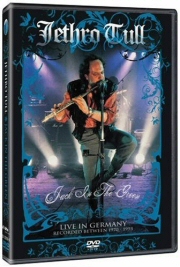 With the temperature dropping, it's time to find someone to keep you warm. Find your hookups with our online dating guide!
With the temperature dropping, it's time to find someone to keep you warm. Find your hookups with our online dating guide!
- Rock
- Unrated
- 2008
- Buy the DVD
Reviewed by R. David Smola
()
es, Deep Purple and Jethro Tull are the progressive rock survivors, bands who combined a surrealistic combination of classical and rock elements and a fantastic degree of musicianship to carve out careers that began in the late ‘60s and continue today. Each of those bands have gone through personnel changes and endured waves of popularity and critical acclaim, but they still manage to put out new recordings every once in a while and tour to receptive and loyal audiences whenever they feel the itch. Tull infused a bit of Renaissance flavor into their prog rock formula, sprinkling flute and mandolin amongst guitar solos, fusion-inspired keyboard work and the distinctive vocals of Ian Anderson.
Jack features performances from five different concerts spanning 1970-1993. The initial set of nine tracks are from 1982, and feature the band in full Middle Ages gear, complete with poofy sleeves and vests. It’s a shame that a band with a sound as interesting and catalog as deep as Tull’s is linked to only a few grossly overplayed classic rock tracks. Every audience that pays a ticket to see Anderson and his band of gypsies wants to hear “Aqualung,” but do they really need to? “Locomotive Breath” and “Thick as a Brick” are, as mandated by federal law, also included on this collection, but they are not nearly the most interesting or entertaining performances.
“Improvisation II” is a delicious piece of musicianship that starts with some guitar gymnastics from Anderson’s one constant foil, Martin Barre, then develops into a wonderful battle between the flute and Barre’s guitar as they exchange leads during the instrumental track. “My Sunday Feeling” has a jazzy big-band feel, while “So Much Trouble” is an acoustic blues tart featuring Anderson working the harmonica and two band members wearing miner’s helmets and white lab coats. These two tracks, taken from a 1993 performance in a very intimate, clublike setting, set the tone as to the range and unique terrain the band covers.
The DVD concludes with two tracks from 1970-1971. Amazingly, armed with significantly more hair, Anderson is the same zany ringleader, animated and playing the hell out of his flute on “With You There to Help Me.” The track also features some wonderful piano and classically influenced soloing from then-member John Evan.
There are only two drawbacks to the collection. “Hunting Girl,” from a 1986 performance, catches Anderson in a very throaty vocal performance; it sounds like it’s an effort to really get the words out. His voice just doesn’t sound right on the track, and it isn’t the best song in the world, either, although it does come with a voiceover introduction in German which sounds like Mike Myers “Sprockets.” Also, the disc features no bonus material. People live for bonus material, but none is found here. Otherwise, this is a wonderful testament to the uniqueness of Jethro Tull.
You can follow us on Twitter and Facebook for content updates. Also, sign up for our email list for weekly updates and check us out on Google+ as well.











